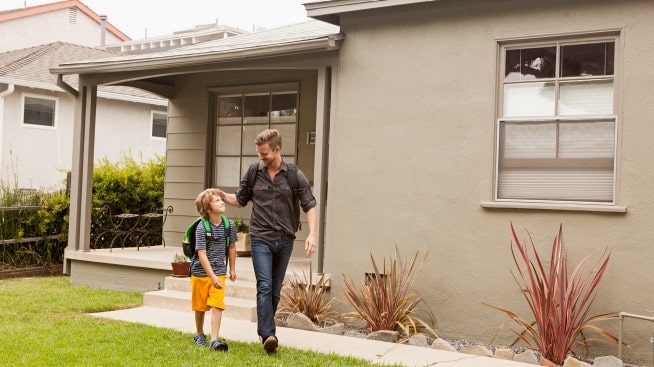What is a bungalow?

Bungalows are just one of many types of houses buyers will see during a search, and their exotic-sounding name may have you wondering, “What is a bungalow?” At its core, a bungalow is usually a small, one-story home with a sloped roof and a covered porch. This architectural style started to spring up in the United States around the early 20th century. To better understand bungalows, let’s take a closer look at their history, common characteristics and key considerations for anyone looking to buy this type of home.
The history and popularity of bungalows
Though bungalows have become a type of home here in the United States, their roots lie in South Asia. In fact, their name comes from the Bengal region of India and modern-day Bangladesh, where this style of house originated. Bungalows were designed to keep people comfortable in the region’s hot weather: the sloped roofs help keep the structure shaded and allow heavy rainfall to flow away from the home. This is just one quality that made the bungalow an attractive design in the United States, especially in the warmer climates of Southern California and Florida.
While bungalows were prevalent in Britain during the 19th century, their popularity didn’t really peak until the early 1900s. Around this time, California architects Charles and Henry Greene found inspiration in the bungalow-style houses of South Asia and introduced their own version of the homes (California bungalows) to the West Coast. The simple, functional design and emphasis on natural aesthetics appealed to the designers, and their style of bungalows became popular in the region, largely thanks to their affordable nature.
On the East Coast, Gustav Stickley (founder of The Craftsman magazine and pioneer of the Craftsman style) employed similar thinking with similar results. On both coasts, the bungalow’s affordable design made homeownership more accessible for the working class without sacrificing aesthetics. As a bonus, these modern-looking homes were able to offer privacy even in rapidly growing neighborhoods.
Eventually, in the 1930’s, the bungalow began to lose its appeal, with homeowners favoring ranch-style and split-level suburban houses. By the 1940’s, the bungalow became synonymous with modest vacation homes, which may be why they’re still prevalently seen in vacation communities.
Understanding bungalow homes
While bungalows share qualities with other homes, there are certain characteristics that make bungalow homes unique. Like ranch style homes, bungalows are generally one-story, though their sloped roofs may occasionally accommodate an extra half- or second-story. Bungalow-style homes tend to have roofs with dormer windows, which bring light into any room with a vaulted ceiling. The sloped roofs of bungalows typically shelter verandas — a style of semi-enclosed porch that may be another enticing bungalow feature for homebuyers to consider.
In terms of layout, bungalows generally feature an open floor plan to encompass the living, dining and kitchen areas, with bedrooms and bathrooms connecting to this communal space. Though most bungalows share these quintessential features, there are many different types of bungalow style houses. Let’s explore the most popular variations.
Types of bungalow style homes
Though most bungalows share certain quintessential features, there are many different types of bungalow style houses. Let’s explore the most popular variations.
Craftsman bungalow
Craftsman bungalow homes are often considered the classic American bungalow-style home, pioneered by interior designer and magazine man Gustav Stickley. These homes are known for their small size, shingled, gabled roofs and relatively easy construction. Keep in mind that Craftsman bungalows are just one subset of the broader Craftsman-style category. That said, most Craftsman homes do still share many of the same attractive features as bungalows in general, such as sloped roofs and simple, clean lines.
California bungalow
These West Coast bungalows share many characteristics with Craftsman bungalows — their East Coast counterparts — but put more emphasis on a natural look. Think redwood shingles or siding, or perhaps stuccos that evoke the Californian desert.
Prairie-style bungalow
Prairie-style bungalows hail from the Midwest, though they gained their name from the Prairie School style of architecture rather than the region itself. Frank Lloyd Wright was a huge proponent of this style, which features strong, wide lines (similar to midcentury modern homes), contrasting materials and an emphasis on natural materials such as wood or stone.
Mission-style bungalow
This style of bungalow, frequently found in Southern California, adopts its aesthetic from Spanish-style architecture. Terra cotta tiles, light-colored or painted stucco and attractive archways are all classic features of Mission-style bungalow homes.
Queen Anne bungalow
Queen Anne bungalows feature Victorian flair, and are more decorative than other bungalow homes, with details such as art-glass windows, ornate picture molding, sculptured chimneys and wrap-around porches.
Benefits of bungalow living
The benefits of bungalow living haven’t changed much since they were first popularized, especially in terms of affordability. In their heyday, many designers and manufacturers offered kits that allowed buyers to purchase pre-cut materials and build their own affordable bungalow homes.
Aside from price, one-story bungalows may be a great option for the elderly or disabled. The lack of stairs is a potential perk for concerned parents as well. But safety isn’t the only upside of bungalow-style living. Their small sizes and low frames may be a boon if you’re looking for a home with low heating and cooling costs. Even if money isn’t an object, bungalow-style homes may be a homestyle to consider for the design-minded homebuyer, with their Arts and Crafts appeal and timeless, natural features.
Considerations before buying a bungalow
Due to their versatility, bungalows may be attractive to many kinds of home buyers, but there are still some important considerations to weigh before pulling the trigger on one of these historic homes. Despite the pluses of one-story living, first floors are particularly vulnerable to burglary, making security a potential concern.
Additionally, as bungalows were most popular about a century ago, it’s likely that many existing bungalows might require some extra renovation. If you’re looking to buy a place as-is, and don’t have the desire to invest effort or money into a bungalow-style house, these homes may not be the best choice for you.
In summary
Next time someone asks, “What is a bungalow?,” you won’t bungle the answer: Bungalows are a functional type of house with a rich global history and a reputation for tasteful design. While they may not be for everyone, bungalows have been an appealing option for many kinds of homeowners for almost a century thanks to their affordability, timeless design and accessibility. As with any home, they have their own unique upsides and downsides, which should be considered carefully when deciding if bungalow-style homes make sense for you.



